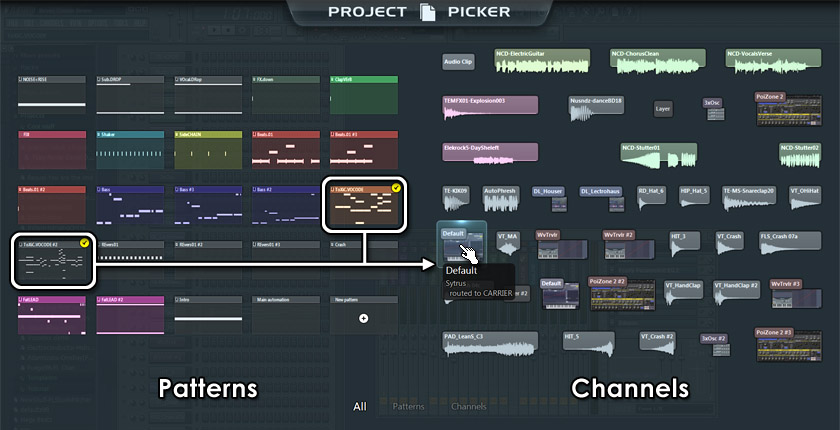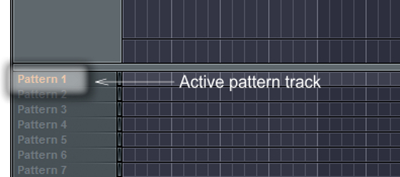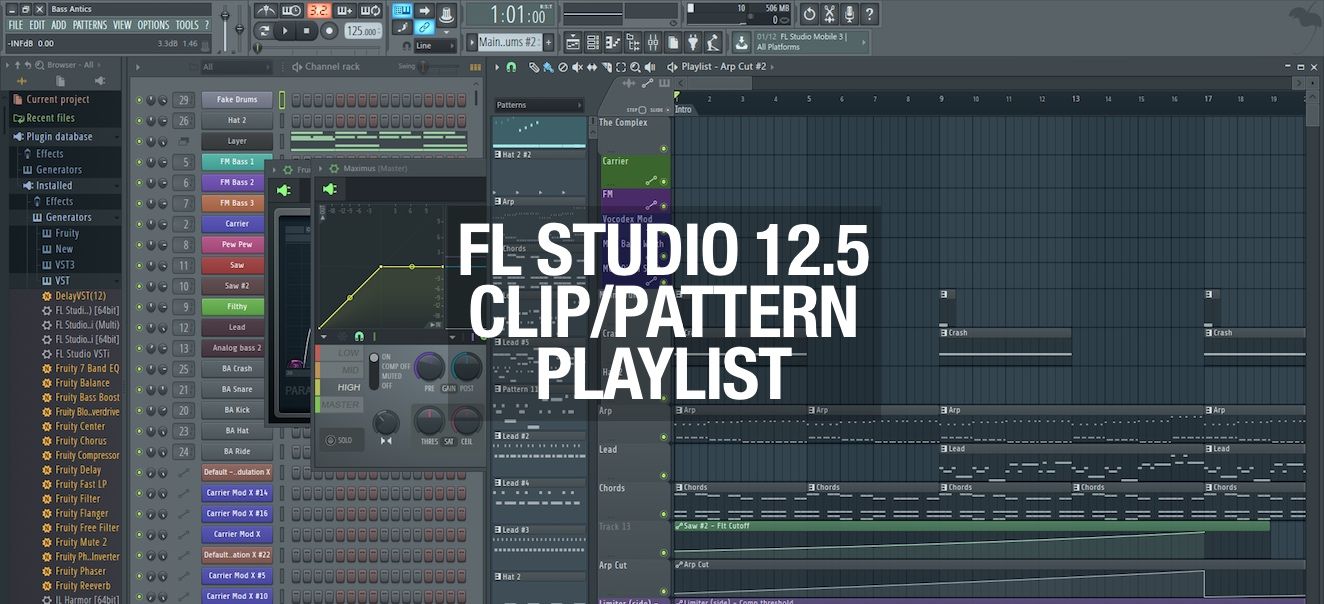Fl Studio Pattern Blocks
In trading, everyone always wants to complicate everything – why? Simply because having 8 screens with a lot of blinking lights is what we see on TV whenever we hear the word trader. Now while some of the infos these people in the pit, or wherever, have on their screens are certainly beneficial, I promise you, you can trade just as profitably with one screen alone and only 1 to 3 indicators, or even no indicators. You don’t even have to read the tape, the DOM, the ladder, the matrix, whatever. You simply have to observe, mainly: lows and highs, and where they occur in relation to the last lows and highs. Sounds familiar? Enter the 1-2-3 pattern. Or, A-B-C pattern, to your liking.
I would pretty much always prefer to manually sequence a vibrato using slides than use an LFO. God, there’s way too many awesome FL features to list. I’m going to forget tons. I definitely couldn’t live without Parametric EQ 2. Its visual component is absolutely irreplaceable. The new playlist, that eliminates pattern blocks, is incredible. Open up FL Studio and you’ll be faced with an empty Pattern complete with four drum sounds, so we’ll launch straight into that and create a simple 4/4 drum pattern over four bars. The advantage of using Patterns is quickly realised when using the Clone option from FL Studio’s many features. 🔥 Best Free Sample Loop Kit Packs 2020 - Works with FL Studio, Logic Pro X, Ableton and any other DAW This heavyweight line up of free sample loops packs is a must-have for any producer wanting to get some quick inspiration in 2020.
This pattern is comprised of a low, a higher high, a higher low, and a break of the higher high (in case we are going long). In the picture above, at the break of point B we are going long, stops go below point C. Some people set a pending order at B, some people wait for a confirmed break. The 1-2-3 pattern works best when going with the trend but can also be used as a reversal pattern when bouncing from S/R and after we have topping structures in place like H&S, double/triple tops and bottoms, etc. The 1-2-3 brings enough momentum with it that we almost always can go to breakeven before price reverses on us, and if it doesn’t, we can get great runs out of this momentum pattern.
Targets are usually Fibonacci extensions and/or the next S/R level, or when we see signs of price exhaustion like divergence on one of our indicators. Here is an example where when the 127.2 extension reached, I usually target the 161.8 – however in this case it was not reached.
Now there is something called the trader’s trick entry, coined by Joe Ross (who also coined the Ross Hook, will get there in a minute). This entry method suggests actually entering between point C and B, before point B is reached – and actually going to breakeven when point B is reached. That way we can make sure we are not going long at a market top. This can be achieved by using Fibonacci retracements, S/R retests, and by other means – what I usually do, however, is to simply look for another 1-2-3 between point B and C, in order to get in (or other patterns, but this is material for another article). Here is an example:
As you can see in the picture above on the right side, between point B and C of the original pattern, we got another 1-2-3 which we could use to get in before we actually reached point B, which in this case saved us from a stressful trade – it would not have been a loss as our SL always goes below point C, but it would have been stressful to say the least.
Now, after point B broke, we have two additional means of stacking our position. One is the retrace to point B, as in this example:
The Ross Hook
And finally, the so-called Ross Hook (basically another 1-2-3), which is the first retrace after a successful 1-2-3 formation. In the example above, we would enter as follows.

So, there you have it, a potential 3 entries on one formation. Important is that you know where the overall trend is going, and that you don’t trade every tiny retrace. This is where my indicators come into play: I use the MACD on the longer timeframe window to confirm momentum, and the CCI on the trading timeframe window to confirm that a pullback has indeed been deep enough to build up enough momentum to the other side (swingin’, swingin’).
If you spot patterns like Head and Shoulders, double tops/bottoms, and other popular topping structures, on the higher timeframe, and a 1-2-3 on the lower timeframe, you got yourself a great trade. Or, you wait until a high or low gets broken on the higher timeframe, and then wait for a 1-2-3 on the lower timeframe to get in. All viable options to enter with the trend, with the momentum, and with structure in your back to protect your stoploss.
Overall, the 1-2-3 is an incredibly awesome pattern that follows the simplest market analysis there is: where are our highs, and where are our lows, and in which relation to each other did they appear on our charts?

The 1-2-3 provides us with clear entries, clear stoplosses and clear targets through extensions. What more could we ask for? Let me know in the comments below what you think!
Sewing Pattern Blocks

- ›
- Making Your Personal Pattern Block
You're ready to make your pattern block!
Using the final fitted muslin, you'll transfer all of your corrections to paper, and then make a cardstock basic block pattern that you'll use again and again to create your new designs. And they'll fit! Hooray!
By now you have assembled your fitting muslin and fit it on yourself or on your body form.
This is my fitting pattern muslin. Overall, it fits the form pretty well.
Take another look to see if anything is still tight, droopy, or uneven. This is your last chance to fix it, so you'll never have to fix it again.

What I found on my dress, unfortunately, is that the side seams on the bodice and skirt did not line up properly, and overall the seam was was not straight.
The red lines indicate the seams as sewn on the final version of the dress. The black line is the corrected seam line. I will make these corrections as I transfer the markings to the paper pattern.
First, take the muslin dress apart along the stitch lines (make sure all stitching lines are clearly marked before taking the dress apart).
Then, trim the pieces along the FINAL, corrected seam lines/dart lines. There should be NO seam allowance on these pieces.
On the sleeve cap, I did not cut the sleeve along the alteration line; I will make that adjustment to the paper pattern.
On the back, I pinned the bodice to shorten it; again, I will make the same folded adjustment to the paper pattern.
After trimming the muslin pieces, lay the muslin piece over the corresponding paper pattern and transfer all seam lines, darts, and other markings made during the fittings. Then trim the paper pattern, as you did the muslin pieces.
The photo at right shows the back bodice laid over the paper pattern (use a ruler to draw straight lines onto the paper pattern). The front bodice (on the left) has already been trimmed.
On the sleeve cap, I measured the distance between the marked lines where I pinched out the excess fullness.
I then removed the same amount (about 1/2') from the top of the sleeve cap on the paper pattern.
If you drafted your block from measurements instead of using a commercial fitting pattern, the process is the same. Use your muslin to transfer your fit adjustments to your paper (drafted) pattern before proceeding to the cardstock tracing.
Before transferring the paper pattern to cardstock to make the pattern block, check that all the pieces fit together.
Tape any darts closed where they meet the seams you are checking. Here, I have taped the side bust dart closed to check the side seams. The waist darts can remain open at this point.
Lining up the front and back bodice at the side seam, I see that the sides are uneven at the waist. I'll add a piece of paper to the front bodice to correct the problem.
Using the same process, I've taped together the waist darts on the bodice and skirt patterns (releasing the bust dart so the pieces lay as flat as possible).
On the front, the bodice and skirt do not match at the waist. This is a reflection of the problem we saw when the final dress was on the form.
I need to add to the bodice side, mostly at the waist, and tapering to nothing at the armhole.To do this, I simply tape a piece of paper to the pattern and re-draw the line.
Pattern Block Sets
The black line on the dress photo, near the top of this page, indicates that the side seam of the bodice needed to be moved back. This is the resulting pattern correction.
Once you've checked all of your pieces to make sure that the seams match and everything fits together, you can transfer the tissue pattern to cardstock for your re-useable pattern block.
Plain white (or light-colored) cardstock is available at craft stores, or the craft section of your sewing center.
Lay the tissue pattern on the cardstock and carefully trace it onto the cardstock. Use a ruler for straight lines and carefully draw curves free-hand (or use a curved ruler, if you'd like).
Do NOT add seam allowances. It is easier to add style lines when you design a new style when there are no seam allowances on the basic block. You'll add seam allowances to your final sewing pattern.
After tracing the tissue pattern onto cardstock, transfer all markings - dart lines, grain lines, notches, dots for marking ease placement, etc.
Also mark center front (CF) and center back (CB) on the bodice and skirt, and the shoulder point on the sleeve cap.
Finally, write the name of the pieced (such as 'Bodice Back'), and any other information you think you will need as you work with the pattern.
I like to add the date (bodies change over time!), and sometimes other notes (such as 'no seam allowance', just to remind me when I'm using the block!).
Finally, cut out the pattern piece, cutting out the darts as well as along the stitch lines. It is much easier to trace the pattern and place the darts when they are cut out of the pattern block.
Now the fun begins - you can design almost anything you want, and use the block pattern to create a sewing pattern for that style.
But first - there's one more block you might want to make.
Personally, I seldom wear anything as fitted as the fitting dress (especially the bodice). So, for convenience in making blouses and tops, you can use your block pattern to make a torso or blouse/top block. It's essentially your introduction to using your block and manipulating it to make a new pattern.
Fl Studio 20 Legacy Pattern Blocks
Ready to start?Let's make a blouse block!
- A Beginner's Guide to Drafting a Dress Block
- Full Bust Adjustment
- Fitting the Pants - Final Fitting
- A Beginner's Guide to Drafting a Pant Block
- The Importance of Sewing Darts
- Pattern Grading
Need More Help with Fitting Issues?
The examples on this site reflect MY fitting issues and how I resolved them. YOUR body is likely very different.
But, since this is a site about MAKING patterns and not specifically about fitting, I'm not going to address other fit issues here. And believe me, there are others who can address this issue better than me.
Any of the books listed below will help you achieve good fit. You can use the techniques on any pattern; but why make the same corrections over an over again? Apply the principles to your block, and the fit corrections YOU need will be automatically built in to every pattern you make!
I can recommend any of the following books to help you achieve good fit, no matter what your size or shape. I own or have used almost all of the books on this list, and have been pleased with how they address fit problems.

Click on the images, below, to go to the item in Amazon. As an Amazon Associate I earn from qualifying purchases. This helps to keep this site free for your use. You are free to search Amazon for these or other similar items without using the affiliate links on this page.
• Pattern Fitting With Confidence- Written by the late Nancy Zieman, host of the TV series 'Sewing with Nancy'. She provides a straightforward, down-to-earth approach to sewing and fitting. Very user-friendly.
• The Complete Photo Guide to Perfect Fitting- I love this book!!! So wonderfully illustrated with photos, using commercial patterns to demonstrate the pattern alterations. It addresses almost any fit problem you might have. So easy to understand and follow!
• Sewing for Plus Sizes - Creating Clothes that Fit and Flatter - A great book for Plus sizes! As a woman gets larger, it's not just the measurements that change - our overall proportions shift, too. This book addresses the different body types and proportions you commonly see in larger women. Truly helpful for larger women.
Return to Clothing Patterns 101 Home Page